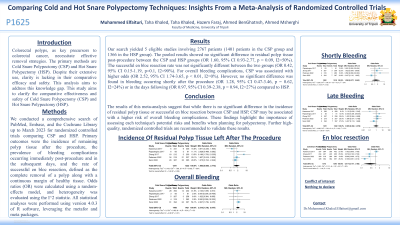Monday Poster Session
Category: Colon
P1625 - Comparing Cold and Hot Snare Polypectomy Techniques: Insights From a Meta-Analysis of Randomized Controlled Trials
Monday, October 23, 2023
10:30 AM - 4:15 PM PT
Location: Exhibit Hall

Has Audio
- ME
Muhammed Elfaituri, MBBCh
University of Tripoli
Tripoli, Tripoli, Libya
Presenting Author(s)
Muhammed Elfaituri, MBBCh, Ala Elfaituri, , Ahmed BenGhatnsh, MBBCh, Hazem Faraj, MBBCh, Ahmed Msherghi, MBBCh
University of Tripoli, Tripoli, Tripoli, Libya
Introduction: Colorectal polyps, as key precursors to colorectal cancer, necessitate effective removal strategies. The primary methods are Cold Snare Polypectomy (CSP) and Hot Snare Polypectomy (HSP). Despite their extensive use, clarity is lacking in their comparative efficacy and safety. This analysis aims to address this knowledge gap. This study aims to clarify the comparative effectiveness and safety of Cold Snare Polypectomy (CSP) and Hot Snare Polypectomy (HSP).
Methods: We conducted a comprehensive search of PubMed, Embase, and the Cochrane Library up to March 2023 for randomized controlled trials comparing CSP and HSP. Primary outcomes were the incidence of remaining polyp tissue after the procedure, the prevalence of bleeding complications occurring immediately post-procedure and in the subsequent days, and the rate of successful en bloc resection, defined as the complete removal of a polyp along with a continuous margin of healthy tissue. Odds ratios (OR) were calculated using a random-effects model, and heterogeneity was evaluated using the I^2 statistic. All statistical analyses were performed using version 4.0.3 of R software, leveraging the metafor and meta packages.
Results: Our search yielded 5 eligible studies involving 2767 patients (1401 patients in the CSP group and 1366 in the HSP group). The pooled results showed no significant difference in residual polyp tissue post-procedure between the CSP and HSP groups (OR 1.60, 95% CI 0.93-2.77, p = 0.09, I2=50%). The successful en bloc resection rate was not significantly different between the two groups (OR 0.42, 95% CI 0.15-1.19, p=0.1, I2=90%). For overall bleeding complications, CSP was associated with higher odds (OR 2.52, 95% CI 1.74-3.65, p < 0.01, I2=0%). However, no significant difference was found in bleeding occurring shortly after the procedure (OR 1.28, 95% CI 0.47-3.46, p = 0.62, I2=24%) or in the days following (OR 0.97, 95% CI 0.39-2.38, p = 0.94, I2=27%) compared to HSP.
Discussion: The results of this meta-analysis suggest that while there is no significant difference in the incidence of residual polyp tissue or successful en bloc resection between CSP and HSP, CSP may be associated with a higher risk of overall bleeding complications. These findings highlight the importance of assessing each technique's potential risks and benefits when planning for polypectomy. Further high-quality, randomized controlled trials are recommended to validate these results.
Disclosures:
Muhammed Elfaituri, MBBCh, Ala Elfaituri, , Ahmed BenGhatnsh, MBBCh, Hazem Faraj, MBBCh, Ahmed Msherghi, MBBCh. P1625 - Comparing Cold and Hot Snare Polypectomy Techniques: Insights From a Meta-Analysis of Randomized Controlled Trials, ACG 2023 Annual Scientific Meeting Abstracts. Vancouver, BC, Canada: American College of Gastroenterology.
University of Tripoli, Tripoli, Tripoli, Libya
Introduction: Colorectal polyps, as key precursors to colorectal cancer, necessitate effective removal strategies. The primary methods are Cold Snare Polypectomy (CSP) and Hot Snare Polypectomy (HSP). Despite their extensive use, clarity is lacking in their comparative efficacy and safety. This analysis aims to address this knowledge gap. This study aims to clarify the comparative effectiveness and safety of Cold Snare Polypectomy (CSP) and Hot Snare Polypectomy (HSP).
Methods: We conducted a comprehensive search of PubMed, Embase, and the Cochrane Library up to March 2023 for randomized controlled trials comparing CSP and HSP. Primary outcomes were the incidence of remaining polyp tissue after the procedure, the prevalence of bleeding complications occurring immediately post-procedure and in the subsequent days, and the rate of successful en bloc resection, defined as the complete removal of a polyp along with a continuous margin of healthy tissue. Odds ratios (OR) were calculated using a random-effects model, and heterogeneity was evaluated using the I^2 statistic. All statistical analyses were performed using version 4.0.3 of R software, leveraging the metafor and meta packages.
Results: Our search yielded 5 eligible studies involving 2767 patients (1401 patients in the CSP group and 1366 in the HSP group). The pooled results showed no significant difference in residual polyp tissue post-procedure between the CSP and HSP groups (OR 1.60, 95% CI 0.93-2.77, p = 0.09, I2=50%). The successful en bloc resection rate was not significantly different between the two groups (OR 0.42, 95% CI 0.15-1.19, p=0.1, I2=90%). For overall bleeding complications, CSP was associated with higher odds (OR 2.52, 95% CI 1.74-3.65, p < 0.01, I2=0%). However, no significant difference was found in bleeding occurring shortly after the procedure (OR 1.28, 95% CI 0.47-3.46, p = 0.62, I2=24%) or in the days following (OR 0.97, 95% CI 0.39-2.38, p = 0.94, I2=27%) compared to HSP.
Discussion: The results of this meta-analysis suggest that while there is no significant difference in the incidence of residual polyp tissue or successful en bloc resection between CSP and HSP, CSP may be associated with a higher risk of overall bleeding complications. These findings highlight the importance of assessing each technique's potential risks and benefits when planning for polypectomy. Further high-quality, randomized controlled trials are recommended to validate these results.
Disclosures:
Muhammed Elfaituri indicated no relevant financial relationships.
Ala Elfaituri indicated no relevant financial relationships.
Ahmed BenGhatnsh indicated no relevant financial relationships.
Hazem Faraj indicated no relevant financial relationships.
Ahmed Msherghi indicated no relevant financial relationships.
Muhammed Elfaituri, MBBCh, Ala Elfaituri, , Ahmed BenGhatnsh, MBBCh, Hazem Faraj, MBBCh, Ahmed Msherghi, MBBCh. P1625 - Comparing Cold and Hot Snare Polypectomy Techniques: Insights From a Meta-Analysis of Randomized Controlled Trials, ACG 2023 Annual Scientific Meeting Abstracts. Vancouver, BC, Canada: American College of Gastroenterology.
